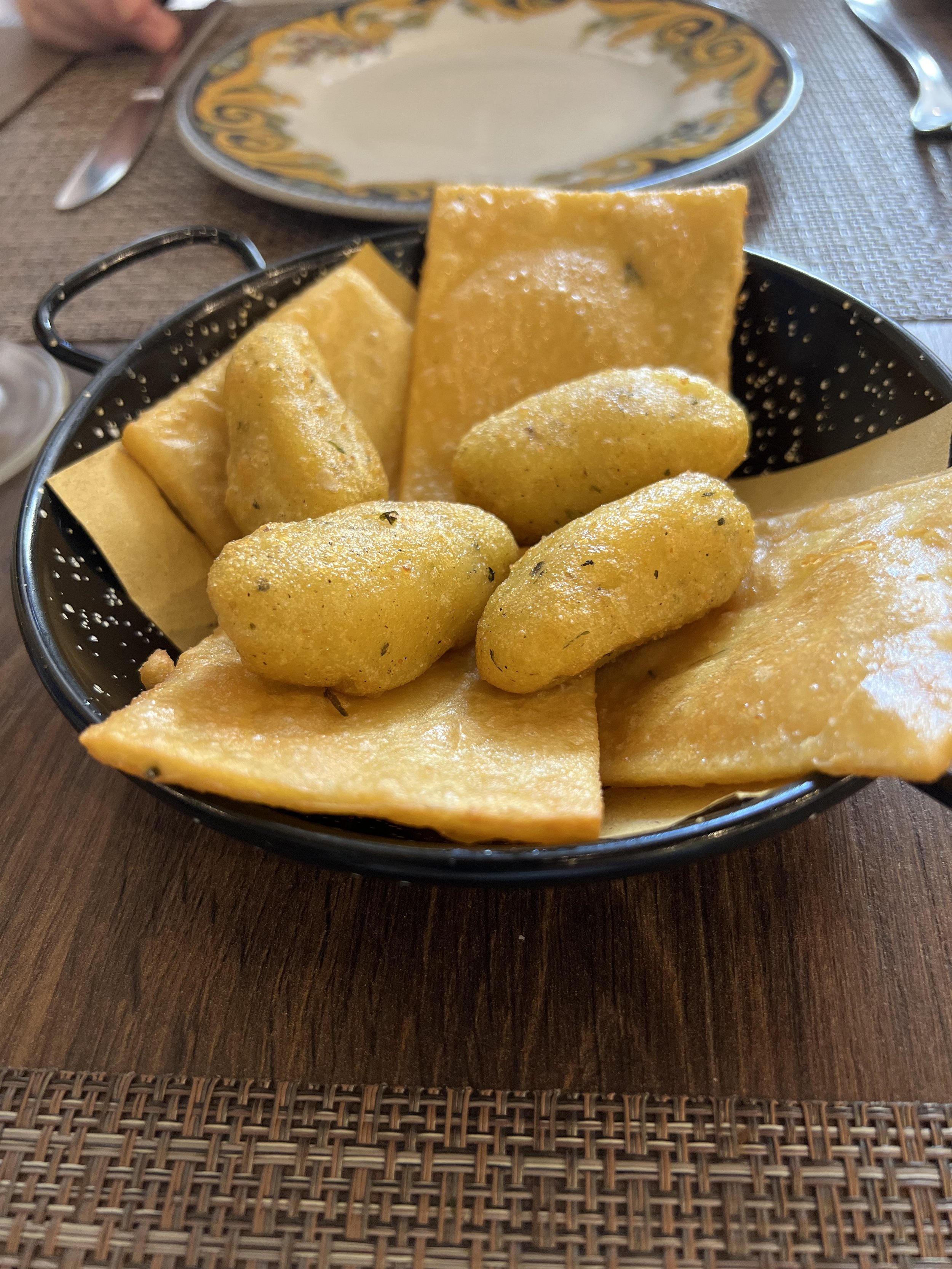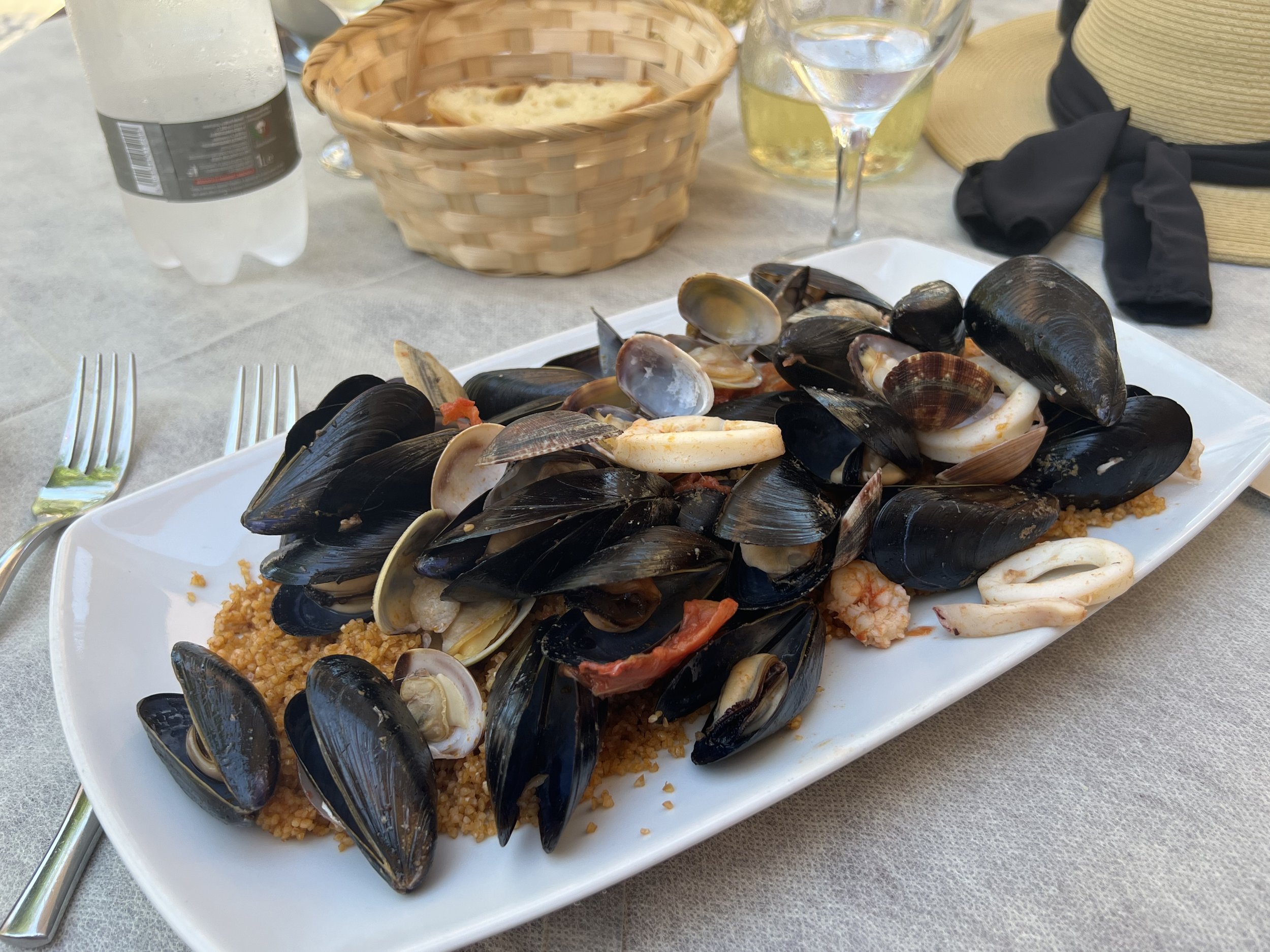The two cities are Palermo and Trapani but you’re going to have to wait to find out about the alien abduction.
We’ve been to Palermo before and (after much vacillation) it will be True Colors home for this winter. There’s no avoiding the perception that Palermo is scruffy - the streets and buildings are dirty and there are weeds growing through the sidewalks in some places. But there’s a vibrancy to the place that is quite infectious and we love it. As I’ve said before this is a city to live in not look at.
Palermo is 2700 years old and has held a strategic position in the central Mediterranean for much of that time. It’s been under the rule of the Phoenicians, Carthaginians, Greeks, Romans, Arabs and Normans. But from the 1100s to the 1800s it was the capital of the Kingdom of Sicily.
This history explains a lot - the language, the architecture, the cuisine and the culture. Sicily is different than the rest of Italy. As one of our restaurant owners put it “I am Italian but I am Sicilian”. The latter trumps the former.
The churches and palaces that we can see today have a vast range of styles (Romanesque, Gothic, Baroque and Art Nouveau) and a tremendous range in age from the 11th century to the 18th and 19th centuries.
We added a “new” church to our list this year - the Church of San Cataldo. Built in 1154 in what is called the “Arab-Norman” style. Given that these two groups tended not to like each other very much, it surprises me that they could get together and come up with a common style. (If the Democrats and Republicans were to build a church, they’d still be arguing about the style in 2154..)
One interesting development is that some churches have started to charge tourists for entry - typically 2 Euros. This is a great way to recoup some of the costs relating ro wear-and-tear. But some people on social media are complaining.
Two Euros is too much to pay for exquisite 1000 year-old religious art and architecture???
It looks like the money is being put to good use though. Palermo Cathedral is getting some overdue work done on the interior and it is really revitalized.
And our favorite church - the Admiral’s Church - is still as astonishingly beautiful as always.
But the traditional working city is still evident. The little harbor where our marina is also is home to the small fishing fleet which continues to fish in the way it has done for many centuries (with the addition of a little technology from time to time).
Also the city is home to three large open-air markets that sprawl through the streets and alleyways of the historic city center. Here you can buy clothing, bric-a-brac, records, religious icons, fish, meat and fruit. At the busiest times they are packed with buyers and sellers - not a good place in the time of COVID, so we wander at quieter times.
For a variety of reasons, we are spending more time in Palermo this year than on our first visit and we are taking the opportunity to sample more of the cuisine. A lot of our perceptions of Italian cuisine are based on many dishes from the north of Italy all the way down to Rome (with the obvious exception of pizza which comes from Naples). Here the influences are fish-driven and many dishes have their roots in North Africa.
Italian restaurants are on three levels - ristorante, trattoria and osteria. Osterias are (supposed to be) the most simple but with a focus on traditional dishes cooking in the traditional style. We sample a couple.
Our first, Osteria Nonna Dora (Grandma Dora’s Osteria) is about as authentic as you can get and is a favorite of locals (always a good sign). It is cheap but the portions can tend to be on the enormous side - as you would expect when you’re at grandma’s table.
Our second example is Osteria Balaro (named after the largest food market in Palermo) which as you can see is perhaps not at the low end of anyone’s restaurant scale.
But Palermo is also famous for its street food. Arancini I the little stuffed rice balls) can be found everywhere.
As can Crocche and Pannelle.
But, and this is not for the faint of heart, Lori decides to try one of the most authentic street foods of the all - Pani Ca Meusa.
For those of you whose Sicilian dialect is not as strong as it might be, this translates to “spleen sandwich”. I’m not sure what a spleen is or what it does but I’m pretty sure I don’t want to eat it. Lori insists it’s excellent but in my experience the only thing you can do with a spleen is vent it.
“More spleen anyone? We’ve got lots!”
With dreams (or is it nightmares) of spleen sandwiches in our heads we set off for Trapani.
And this is where the alien abduction takes place.
We are crossing the Gulf of Castellamare (the roots of three of the prominent New York Mafia families are in this area) motor-sailing with the mainsail up. The wind is changing but I head below and Lori is at the helm.
I hear the engine revs reduce until we are only idling but being pushed forward by the wind in our mainsail. The wind is now behind us and gradually increasing.
I look at Lori who has a big grin on her face and she says “I wondered how fast we could go without the engine”. (The answer is “8 knots” by the way).
But my wife has always been nervous of running before the wind. She has visions of crash gybes , people being knocked overboard by the boom and True Colors being dismasted. So I know while this may look like my wife it is not in fact my wife.
Alien abduction alert!
I say “What have you done with my wife?” And then add in a more conciliatory tone, “Welcome to Earth.”
Lori insists that she has not been abducted but I’m watching and taking notes. I’ve seen “Invasion of the Body Snatchers”. I think I’ll offer her another spleen sandwich as a test.
We reach Trapani, the provincial capital on the northwest coast of the island. It has a large commercial harbor which accommodates a sizable fishing fleet.
And a lot of inter-island ferry traffic - particularly to the Egadi islands which are our next cruising ground.
But before that Trapani itself.
The town dates back to at least 250BC and has pretty much the same cast of conquerors as the rest of Sicily. The area close to the harbor has commercial feel but as you wander towards the historic center the Baroque architecture and the old street patterns are revealed.
In a cafe on a street corner we sample another Sicilian street food specialty - granita ca brioscia.
Lori liked this so much she ate most of it before deciding to take a photograph of it.
Instead of coffee and a croissant, Sicilians opt for a simple brioche bun and a a fruit-flavored water ice (granita) which was invented here in Sicily.
The flavor this time is pomegranate which are in abundant display on the stall outside the cafe.
Trapani also has a thriving art scene which most visibly manifests itself during the summer with outdoor opera and theater as well as street art in a tree-lined park.
For those of you who have a puny temperamental ficus in your home. To paraphrase Crocodile Dundee, “That’s not a ficus; these are ficus!”
Only for kids to play on - there was a guy who’d blow a whistle if any adult (including parents) went anywhere near the art.
This corner of Sicily is also known for its couscous with both Trapani and San Vito lo Capo to the north being renowned for their variants of this dish. Indeed San Vito has hosted the World CousCous Championships for the last 25 years. Couscous probably originated in Algeria or Morocco and is a classic example of how Arab ingredients and dishes infuse the Sicilian cuisine.
So, if there is couscous, there have to be couscouserias (or cuscuserias in the Sicilian dialect) - restaurants specializing in couscous.
Finally, Trapani is also famous for salt. The salt pans are just south of the town. Last time we didn’t make there but this time we tried. However, in the time of COVID we are not comfortable riding in a little bus with eight or ten of our new closest friends (even if we are required to wear a mask by law). So we think about a little ferry tour that takes the short trip across the harbor to the salt pans. We go to the ferry quay at the designated time, but no ferry tour. We ask around, no-one knows.
As we yet again contemplate failure to see salt drying, we are comforted by the thought that it may be just like watching paint dry.























